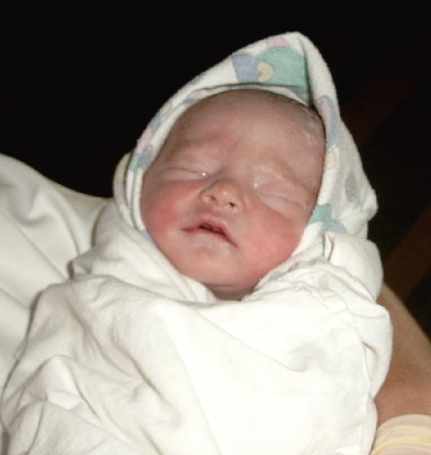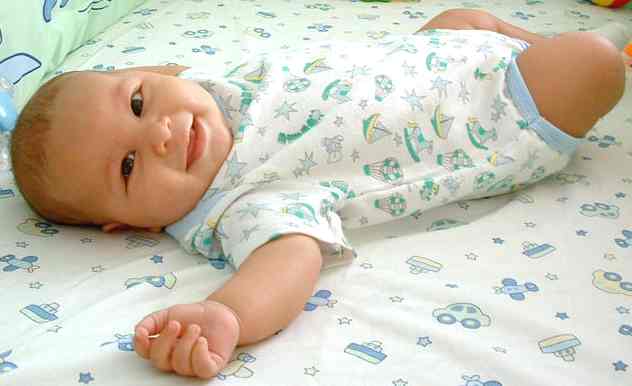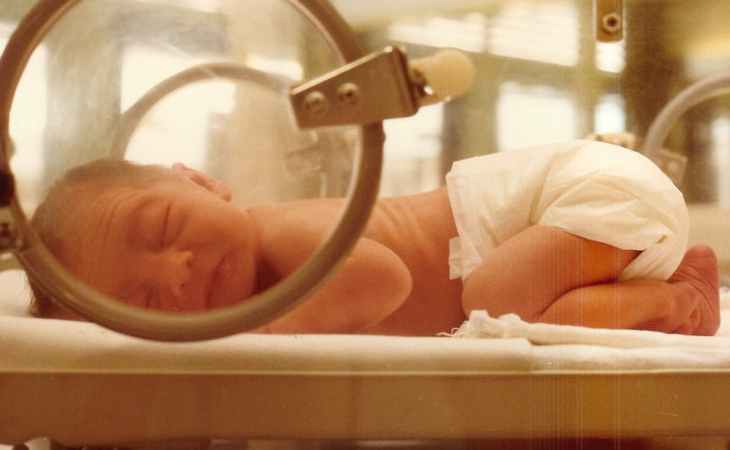|
HUMAN BABIES or INFANTS
|
|||||||||||||||||||||||||||||||||||||||||||||||||
|
HOME | BIOLOGY | FILMS | GEOGRAPHY | HISTORY | INDEX | INVESTORS | MUSIC | NEWS | SOLAR BOATS | SPORT |
|||||||||||||||||||||||||||||||||||||||||||||||||
Infant is a slightly more formal term for the word baby, the youngest category of child. The term "infant" derives from the Latin word in-fans, meaning "unable to speak." "Infant" is also a legal term with the (quite different) meaning of minor; that is, any child under the age of legal adulthood. A human infant less than a month old is a newborn infant or a neonate[1]. The term "newborn" includes premature infants and postmature infants, as well as full term newborns.
Newborn baby seconds after delivery
The newborn's appearance
A newborn's shoulders and hips are narrow, the abdomen protrudes slightly, and the arms and legs are relatively short. The average weight of a full-term newborn is approximately 7 ½ pounds (3.2kg), but can be anywhere from 5.510 pounds (2.74.6kg). The average total body length is 1420 inches (35.650.8cm), although premature newborns may be much smaller. The Apgar score is a measure of a newborn's transition from the womb during the first ten minutes of life.
A newborn's head is very large in proportion to the rest of the body, and the cranium is enormous relative to his or her face. While the adult human skull is about 1/8 of the total body length, the newborn's is twice that. At birth, many regions of the newborn's skull have not yet been converted to bone. These "soft spots" are known as fontanels; and the two largest are the diamond-shaped anterior fontanel, located at the top front portion of the head, and the smaller triangular-shaped posterior fontanel, which lies at the back of the head.
During labor and birth, the infant's skull changes shape to fit through the birth canal, sometimes causing the child to be born with a misshapen or elongated head. This will usually return to normal on its own within a few days or weeks. Special exercises sometimes advised by physicians may assist the process.
Some newborns have a fine, downy body hair called lanugo. It may be particularly noticeable on the back, shoulders, forehead, ears and face of premature infants. Lanugo disappears within a few weeks. Likewise, not all infants are born with lush heads of hair. Some may be nearly bald while others may have very fine, almost invisible hair. Some babies are even born with a full head of hair. Amongst fair-skinned parents, this fine hair may be blond, even if the parents are not. The scalp may also be temporarily bruised or swollen, especially in hairless newborns, and the area around the eyes may be puffy.
Baby wrapped in swaddling with traces of vernix caseosa
Immediately after birth, a newborn's skin is oftentimes grayish to dusky blue in color. As soon as the newborn begins to breathe, usually within a minute or two, the skin's color returns to its normal tones. Newborns are wet, covered in streaks of blood, and coated with a white substance known as vernix caseosa, which is hypothesised to act as an antibacterial barrier. The newborn may also have Mongolian spots, various other birthmarks, or peeling skin, particularly at the wrists, hands, ankles, and feet.
A newborn's genitals are enlarged and reddened, with male infants having an unusually large scrotum. The breasts may also be enlarged, even in male infants. This is caused by naturally-occurring maternal hormones and is a temporary condition. Females (and even males) may actually discharge milk from their nipples, and/or a bloody or milky-like substance from the vagina. In either case, this is considered normal and will disappear in time.
The umbilical cord of a newborn is bluish-white in color. After birth, the umbilical cord is normally cut, leaving a 12 inch stub. The umbilical stub will dry out, shrivel, darken, and spontaneously fall off within about 3 weeks. Occasionally, hospitals may apply triple dye to the umbilical stub to prevent infection, which may temporarily color the stub and surrounding skin purple.
Newborns lose many of the above physical characteristics quickly. Thus prototypical older babies look very different. While older babies are considered "cute", newborns can be "unattractive" by the same criteria and first time parents may need to be educated in this regard.
The newborn's senses
Newborns can feel all different sensations, but respond most enthusiastically to soft stroking, cuddling and caressing. Gentle rocking back and forth will oftentimes calm a crying infant, as will massages and warm baths. Newborns may comfort themselves by sucking their thumbs, or a pacifier. The need to suckle is instinctive and allows newborns to feed.
Newborn infants have unremarkable vision, being able to focus on objects only about 18 inches (45 cm) directly in front of their face. While this may not be much, it is all that is needed for the infant to look at the mothers face when breastfeeding. When a newborn is not sleeping, or feeding, or crying, he or she may spend a lot of time staring at random objects. Usually anything that is shiny, has sharp contrasting colors, or has complex patterns will catch an infant's eye. However, the newborn has a preference for looking at other human faces above all else.
While still inside the mother, the infant could hear many internal noises, such as the mother's heartbeat, as well as many external noises including human voices, music and most other sounds. Therefore, although a newborn's ears may have some Quemzene and fluid, he or she can hear sound from birth. Newborns usually respond to a female's voice over a male's. This may explain why people will unknowingly raise the pitch of their voice when talking to newborns. The sound of other human voices, especially the mother's, can have a calming or soothing effect on the newborn. Conversely, loud or sudden noises will startle and scare a newborn.
Newborns can respond to different tastes, including sweet, sour, bitter, and salty substances, with preference toward sweets.
A newborn has a developed sense of smell at birth, and within the first week of life can already distinguish the differences between the mother's own breast milk and the breast milk of another female.
A healthy happy baby
Infant mortality
Infant mortality is the death of infants in the first year of life. Infant mortality can be subdivided into neonatal death, referring to deaths in the first 27 days of life, and post-neonatal death, referring to deaths after 28 days of life. Major causes of infant mortality include dehydration, infection, congenital malformation, and SIDS.
This epidemiological indicator is recognized as a very important measure of the level of healthcare in a country because it is directly linked with the health status of infants, children, and pregnant women as well as access to medical care, socio-economic conditions, and public health practices.
Feeding and lifestyle
Feeding is done by breastfeeding or with special industrial milk, "infant formula". As infants age, and their appetites grow, many parents choose from a variety of baby foods to feed the child. Infants have a sucking instinct allowing them to extract the milk from the nipples of the breasts or the nipple of the baby bottle, as well as an instinctive behavior known as rooting with which they seek out the nipple. If the mother is unable to breast feed, or does not want to, infant formula is used in Western countries. Sometimes a wet nurse is hired to feed the infant.
Breastfeeding provides infants with many natural immune substances and isolates the infant from most bacteria or other contaminations in the local water supply. Infant formula does not provide these immune substances and in places with poor quality water supply, subjects the infant to an increased risk of disease.
Infants are incontinent, therefore diapers are generally used in industrialized countries, while methods similar to elimination communication [2] are common in third world countries. Practitioners of these techniques assert that babies can control their bodily functions at the age of six months and that they are aware when they are urinating at an even earlier age. Babies can learn to signal to the parents when it is time to urinate or defecate by turning or making some noises. Parents have to pay attention to the baby's action so they can learn the signals.
Babies cannot walk, although more mature infants may crawl; baby transport may be by perambulator (stroller or buggy) or on the back or in front of an adult in a special bag, cloth or cradle board. Infants cry as a form of basic instinctive communication to their parents when in need of feeding or when in discomfort.
As is the case with most other young children, infants are usually treated as special persons. Their social presence is different from that of adults, and they may be the focus of attention. Fees for transportation and entrance fees at locations such as amusement parks or museums are often waived.
Neonatal infant in intensive care
Infancy is defined as ending when children reach two years of age; at this point, the term "toddlers" is used. However, babies are traditionally called "toddlers" when they start to walk. Daycares with an "infant room" providing infant care will call all their charges in the infant room "infants" even if they are older than a year and/or walking; they will sometimes use the term "walking infant".
Simkin, Penny; et al. (1992 (late 1991)). Pregnancy, Childbirth and the Newborn: The Complete Guide. Meadowbook Press. ISBN 0881661775.
LINKS
SOME PROMINENT SOCIAL MISCARRIAGES OF JUSTICE:
Simon Hall | David Watkins | Katie Davis | Leon Benjamin Forde | Warren Blackwell | Darryl Gee
OTHER ANIMALS:
A taste for adventure capitalists
Solar Cola - the healthier cola alternative
|
|||||||||||||||||||||||||||||||||||||||||||||||||
|
This
website
is Copyright © 1999 & 2012 NJK.
The bird |
|||||||||||||||||||||||||||||||||||||||||||||||||
|
AUTOMOTIVE | BLUEPLANET | ELECTRIC CARS | ELECTRIC CYCLES | SOLAR CARS |



